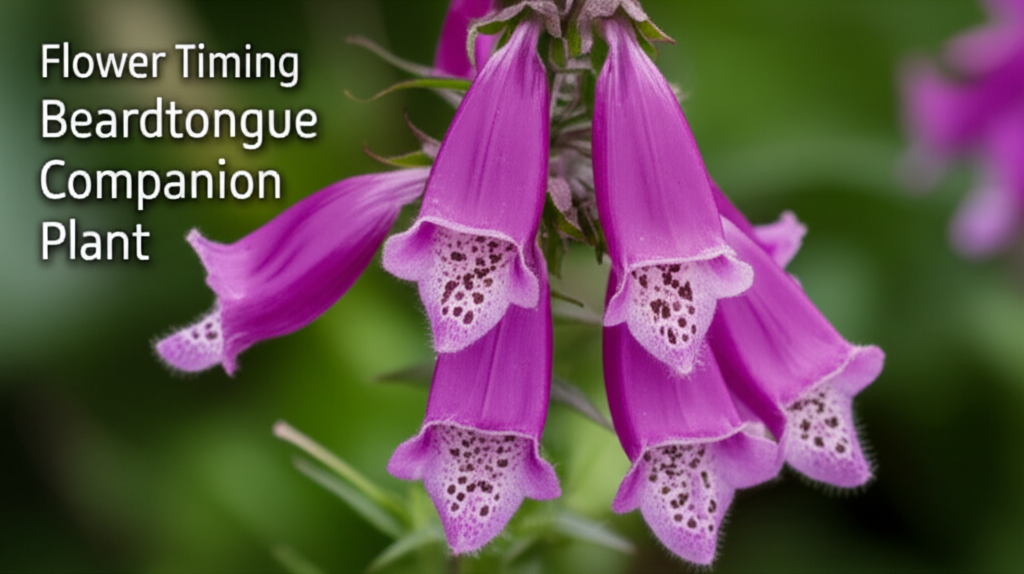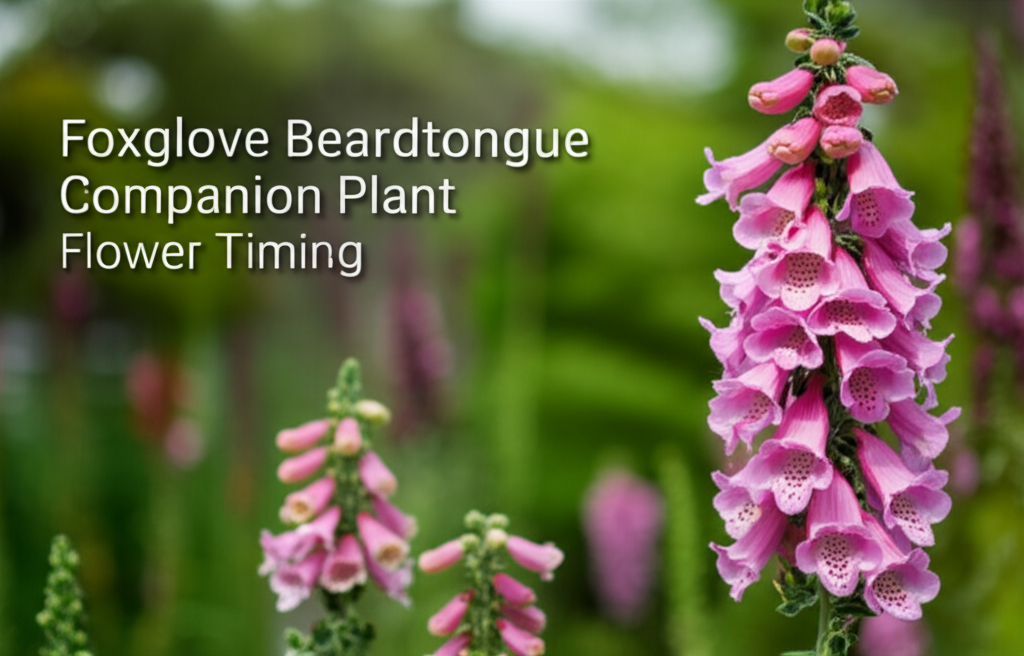Understanding Foxglove Beardtongue (Penstemon digitalis)
Foxglove Beardtongue, scientifically known as Penstemon digitalis, is a captivating native wildflower that graces many North American gardens with its elegant spires of white to pale pink tubular flowers. Often found in prairies, meadows, and open woodlands, this perennial boasts a robust nature, adaptability, and a significant appeal to a variety of pollinators, especially bees and butterflies. Its upright growth habit and attractive foliage make it a valuable addition to any landscape seeking natural beauty and ecological benefit.
Key Characteristics of Foxglove Beardtongue:
- Height: Typically reaches 2-4 feet.
- Bloom Time: Late spring to early summer (May to June, sometimes extending into July).
- Sunlight Requirements: Prefers full sun to partial shade.
- Soil Preferences: Adaptable to a range of soils, but thrives in well-drained, moist to average conditions. Tolerant of clay soils.
- Native Range: Eastern and central North America.
- Pollinator Attraction: Highly attractive to bees, butterflies, and hummingbirds.
- Drought Tolerance: Moderately drought tolerant once established.
The Art and Science of Companion Planting

Companion planting is an age-old horticultural practice that involves growing different plant species in close proximity to one another. The primary goal is to create a symbiotic relationship where the plants mutually benefit, whether through improved growth, pest deterrence, nutrient sharing, or enhanced aesthetic appeal. This approach is rooted in understanding the specific needs and characteristics of each plant and how they can interact positively in a shared environment.
Benefits of Companion Planting:
- Pest and Disease Management: Certain plants can repel or attract beneficial insects, thereby reducing pest pressure.
- Improved Soil Health: Nitrogen-fixing plants can enrich the soil, while deep-rooted plants can improve soil structure.
- Enhanced Growth: Some companions can provide shade, windbreaks, or support to their neighbors.
- Attracting Beneficial Insects: Planting flowers that attract pollinators and predatory insects can boost the overall health of the garden ecosystem.
- Aesthetic Appeal: Combining plants with different bloom times, colors, and textures creates a visually dynamic and enduring garden display.
Foxglove Beardtongue: Its Blooming Period and Needs
To effectively choose companion plants, it is crucial to understand the specific requirements and bloom timing of Foxglove Beardtongue. As mentioned, its primary flowering period is late spring to early summer. This means that companion plants should be selected to either complement this bloom, extend it, or provide interest before or after the Penstemon digitalis takes center stage.
Key Needs of Foxglove Beardtongue:
- Sunlight: Full sun to partial shade is ideal. More sun generally leads to more prolific blooming.
- Water: While it tolerates average moisture, it performs best with consistent, moderate watering, especially during dry spells. Good drainage is essential to prevent root rot.
- Soil: Adaptable, but prefers well-drained soils. It can tolerate heavier clay soils if amended for drainage.
- Spacing: Plants typically grow about 1-2 feet wide, so allow adequate space for airflow and growth.
Companion Planting Strategies for Foxglove Beardtongue
The strategy for selecting companions for Foxglove Beardtongue revolves around enhancing its natural beauty and ecological function. We can aim for plants that:
- Bloom before or after: To ensure continuous floral interest.
- Provide contrasting textures and forms: To create visual depth.
- Attract similar or complementary pollinators: To maximize biodiversity.
- Offer similar growing conditions: To simplify garden care.
Companion Plants for Early Spring Bloom (Before Foxglove Beardtongue):
These plants will provide color and life to the garden before the Penstemon digitalis begins its main show.
- Columbine (Aquilegia spp.): With its unique spurred flowers, Columbine offers early spring color in shades of red, pink, yellow, and purple. It prefers similar conditions of sun to partial shade and moist, well-drained soil.
- Wild Geranium (Geranium maculatum): This native woodland perennial provides lovely pink to lavender flowers in early to mid-spring. It thrives in partial shade and moist, well-drained soils, making it a perfect understory companion.
- Pasqueflower (Pulsatilla spp.): Known for its fuzzy, bell-shaped flowers that appear very early in spring, often before the last frost. It prefers full sun and well-drained soil.
Companion Plants for Mid-to-Late Spring Bloom (Overlapping or Following Foxglove Beardtongue):
These companions will extend the blooming season or offer a similar bloom time for a layered effect.
- Coneflower (Echinacea spp.): Particularly Echinacea purpurea (Purple Coneflower), this prairie staple offers daisy-like flowers in shades of purple, pink, and white. It blooms from mid-summer into fall, providing a long-lasting display and attracting numerous pollinators. It thrives in full sun and well-drained soil.
- Milkweed (Asclepias spp.): Especially Butterfly Weed (Asclepias tuberosa) for its vibrant orange flowers and Common Milkweed (Asclepias syriaca) for its fragrant pinkish blooms. Milkweed is crucial for Monarch butterflies and blooms from mid-summer. It prefers full sun and well-drained soil.
- Black-Eyed Susan (Rudbeckia hirta): A cheerful, classic prairie flower with bright yellow petals and dark brown centers. It blooms from mid-summer through fall, offering a consistent splash of color. Prefers full sun and well-drained soil.
- Salvia (Salvia spp.): Many varieties, like Meadow Sage (Salvia nemorosa) and its cultivars, offer spikes of blue, purple, or pink flowers. They bloom from late spring through summer, often with a second flush of blooms if deadheaded. They prefer full sun and well-drained soil.
Companion Plants for Fall Bloom (Extending the Season):
These plants will ensure the garden remains vibrant and attractive as summer wanes and into autumn.
- Asters (Symphyotrichum spp.): Especially New England Aster (Symphyotrichum novae-angliae) and New York Aster (Symphyotrichum novi-belgii), these provide a profusion of purple, pink, and white daisy-like flowers from late summer through fall. They are excellent for late-season pollinators. Prefer full sun and well-drained soil.
- Goldenrod (Solidago spp.): Despite its undeserved reputation for causing allergies (ragweed is the culprit), Goldenrod offers brilliant plumes of yellow flowers in late summer and fall, feeding pollinators before winter. Many species are well-behaved. Prefer full sun and well-drained soil.
- Joe-Pye Weed (Eutrochium spp.): Tall and majestic, Joe-Pye Weed offers large, fluffy heads of pinkish-purple flowers in late summer and early fall. It loves moist soil and full sun to partial shade, making it a good partner for slightly moister garden locations.
Companion Planting for Specific Garden Conditions
The choice of companions can also be tailored to specific garden conditions, such as soil type, moisture levels, and desired aesthetic.
For Moist to Average Soil Conditions:
Foxglove Beardtongue generally prefers consistent moisture and is adaptable to average soil. Companions that share this preference will thrive alongside it.
- Bee Balm (Monarda spp.): Another pollinator magnet, Bee Balm offers tubular flowers in shades of red, pink, and purple. It blooms from mid-summer and prefers moist soil and full sun to partial shade.
- Blue Flag Iris (Iris versicolor): A beautiful native iris that tolerates moist to wet conditions and blooms in late spring with striking blue-violet flowers.
- Swamp Milkweed (Asclepias incarnata): Prefers moist to wet soils and produces fragrant pink flowers in mid-summer, a vital food source for Monarch caterpillars.
For Well-Drained, Sunnier Locations:
If your Foxglove Beardtongue is in a prime sunny spot with excellent drainage, consider these drought-tolerant and sun-loving companions.
- Lavender (Lavandula spp.): Known for its fragrant purple spikes and drought tolerance once established. It blooms from early summer and prefers full sun and excellent drainage.
- Yarrow (Achillea millefolium): Offers flat-topped clusters of flowers in various colors (yellow, white, pink, red) and is very drought tolerant. Blooms from late spring through summer.
- Russian Sage (Perovskia atriplicifolia): With its silvery foliage and airy spikes of lavender-blue flowers, it blooms from mid-summer into fall and is extremely drought tolerant.
Key Facts Comparison: Foxglove Beardtongue and Companion Plants
This table highlights the similarities and differences in key aspects of popular companion plants for Penstemon digitalis.
| Plant Name | Scientific Name | Bloom Time | Height (ft) | Sunlight Needs | Soil Preference | Key Pollinators |
|---|---|---|---|---|---|---|
| Foxglove Beardtongue | Penstemon digitalis | Late Spring – Early Summer | 2-4 | Full Sun – Partial Shade | Well-drained, Moist to Average | Bees, Butterflies, Hummingbirds |
| Purple Coneflower | Echinacea purpurea | Mid-Summer – Fall | 2-4 | Full Sun | Well-drained | Bees, Butterflies |
| Butterfly Weed | Asclepias tuberosa | Mid-Summer | 1-3 | Full Sun | Well-drained | Butterflies (especially Monarchs), Bees |
| Blue Flag Iris | Iris versicolor | Late Spring | 2-3 | Full Sun – Partial Shade | Moist – Wet | Bees |
| Meadow Sage | Salvia nemorosa | Late Spring – Summer (Repeat Bloom) | 1-3 | Full Sun | Well-drained | Bees, Butterflies |
| New England Aster | Symphyotrichum novae-angliae | Late Summer – Fall | 3-6 | Full Sun | Well-drained | Bees, Butterflies |
Pros and Cons of Companion Planting with Foxglove Beardtongue
Considering the benefits and potential drawbacks is crucial for successful garden implementation.
| Aspect | Pros | Cons |
|---|---|---|
| Aesthetic Appeal | Creates layered color, texture, and bloom times, enhancing visual interest throughout the season. | Poorly chosen companions can compete visually or create a “busy” look if not planned carefully. |
| Biodiversity & Pollinator Support | Attracts a wider range of pollinators and beneficial insects by providing diverse nectar and pollen sources. | Some aggressive companion plants could potentially outcompete native plants if not managed. |
| Garden Maintenance | Plants with similar needs simplify watering and soil care. | Companions with very different needs (e.g., extremely dry vs. very wet) can complicate watering schedules. |
| Pest & Disease Management | Certain companions can help deter pests or attract natural predators. | Some companion plants might attract their own set of pests or diseases that could spread. |
| Space Utilization | Efficiently uses garden space by growing complementary plants together. | Overcrowding can occur if plants are not spaced correctly, leading to poor air circulation and increased disease risk. |
Steps to Implementing Companion Planting for Foxglove Beardtongue
Successfully integrating companion plants involves a systematic approach.
- Assess Your Site: Evaluate the sunlight, soil type, and moisture levels in the area where you plan to plant Foxglove Beardtongue.
- Research Companion Needs: Select plants whose needs (sun, water, soil) closely match those of Penstemon digitalis to simplify care.
- Consider Bloom Times: Aim for a succession of blooms by choosing plants that flower before, during, and after the peak bloom of Foxglove Beardtongue.
- Think About Form and Texture: Combine upright flowers like Penstemon with mounding or spreading plants, or plants with different leaf shapes and colors for visual appeal.
- Plan for Pollinator Synergy: Select plants that attract pollinators you want to encourage, such as bees and butterflies, to create a vibrant ecosystem.
- Spacing is Key: Ensure adequate spacing between all plants to allow for mature growth, air circulation, and to prevent excessive competition for resources.
- Planting Strategy: Consider planting taller companions behind Foxglove Beardtongue for a layered effect, or shorter, spreading plants at its base.
- Monitor and Adjust: Observe your garden throughout the season. Some companions may prove more vigorous than anticipated, requiring occasional thinning or relocation.
Conclusion: Cultivating a Harmonious Garden
By thoughtfully selecting companion plants, you can transform a garden featuring Foxglove Beardtongue into a dynamic, resilient, and visually stunning ecosystem. The goal is to create a tapestry of blooms that not only delights the eye but also supports local wildlife and reduces the need for intensive garden management. Embracing companion planting with Penstemon digitalis is a step towards a more natural, sustainable, and rewarding gardening experience, ensuring beauty and ecological benefit from early spring through late autumn.


